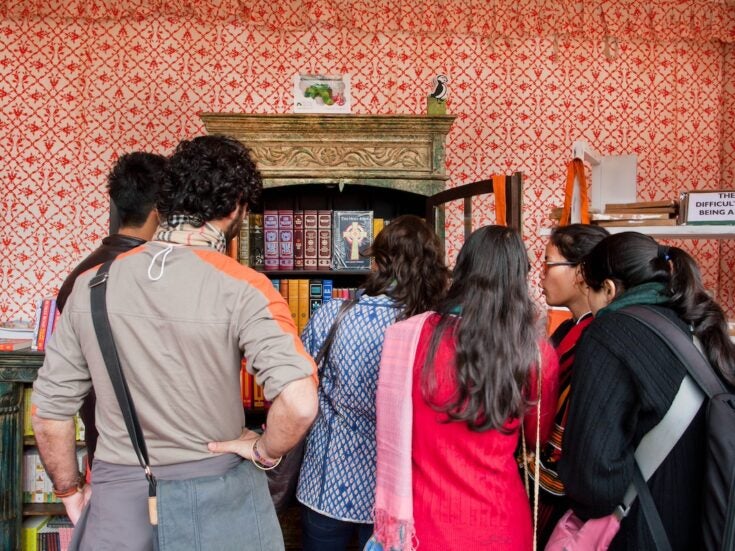Jungian platitudes with a side order of sea parsley? Vanessa Neumann on the curious notions we are willing to entertain in our annual rush to self-reinvention
Jungian platitudes with a side order of sea parsley? Vanessa Neumann on the curious notions we are willing to entertain in our annual rush to self-reinvention
‘New Year, New You!’ beam a panoply of women’s magazines every January, giving hope to all after yet another year when romances or families or careers have disappointed.
Despair not, they seem to proclaim, for we get another chance, and, in a triumph of faith over experience, we fall for it, launching ourselves into yet another solipsistic pet project. Usually too sceptical to go in for these, this year I was softer and more susceptible. More hopeful? More desperate? Maybe both.
After working my way through the unoriginal ‘give up smoking’ (moderately successful), I remained unsatisfied and decided to undertake a fundamental refurbishment from the outside in.
Yes, I started to go to the gym more, and my waistline began to shrink nicely, but still that was not enough. Who would have known that meeting resolutions could be so deeply unsatisfying?
Then, as if in answer to my silent musings, Crème de la Mer asked whether I might like to test-drive their new £1,500 Essence cream. Of course I would. Who wouldn’t want to be given the non plus ultra of the world’s most coveted face cream?
Everything about it is mythic: it was developed by a badly burnt aerospace physicist to heal his own face, and he passed it around a coterie of friends as tight-lipped as a secret society — until Estée Lauder bought it and launched a major campaign.
As I smooth it on my skin I picture the fishermen, sailing out twice a year under a full moon on to the black heaving sea to cull the sea kelp, the core ingredient in the Miracle Broth© that is at the heart of all Crème de la Mer creams.
The £1,500 Essence adds sea parsley and hibernating narcissus bulb, so I comfort myself with the thought that if all else fails, I could eat the creams as part of my new health regimen.
The packaging, three slim shimmering vials standing like sentries in a magnetised base, seems better suited to the Hope Diamond, and is a far cry from the churning son et lumière of mariponics that are used to create this stuff — rather like the hydroponics of your hippie university friends, only in sea water.
I apply my creams as directed and await my visible miracle of rejuvenation, which can take as long as 21 days. In the meantime, I’m restless again.
Then I get an email from a friend asking whether I might be interested in meeting (and possibly interviewing for the political magazine I edit) a Jungian psychotherapist who can bring peace not only to tortured, traumatised souls but also to entire warring factions in the Middle East, and routinely advises Truth and Reconciliation Commissions after genocides. Her speciality is conflict resolution; I’m hoping she can address my own conflict with this resolution business.
I find her in one of the grandest houses in Holland Park. Conflict is good business, it seems. After three hours of Hollywood-style, we-are-each-capable-of-incredible-cruelty-as-well-as-miraculous-forgiveness, and you-must-forgive-yourself-before-you-forgive-anyone-else, I am bizarrely relaxed and magnanimous toward my fellow man.
Before I leave, she hands me some reading material and gives me some relaxing meditation exercises to practise daily: homework. They will change the way I think about things, she tells me, and I instantly feel my usual hard-edged scepticism melting away.
Slipping into my car, I decide to phone a friend I had told to sod off three days earlier. Would you like to meet for dinner? I think we’ve both made mistakes, I explain. I catch a glimpse of myself in the mirror. Where did it get so complicated?
When I was 21 I gave my first major magazine interview (I was a nationally televised reviewer of children’s books, aged nine) in a ludicrous magazine called Poder (‘Power’). In the interview I expounded on the importance of living with conviction, according to well-considered principles that allowed me to look myself in the mirror every morning. I had life sussed, I thought.
That’s what’s so astounding about being 21: life is so black-and-white, so right-and-wrong, so I-would-never. When I was lecturing two years ago, a friend asked me what I found most interesting about my university students. ‘Their certainty,’ I replied. ‘Their absolute certainty about everything.’
In my mid-thirties, it’s a different story entirely and I’ve developed compassion for those I would have criticised, as I have learned to make my own compromises for the greater good: of my marriage, of my career. Too old to be naïve and too young to be irretrievably compromised, in your mid-thirties you still have a choice.
You can hear the clock ticking and see the door shutting on the ‘you’ you had dreamed of becoming, and you can still make a dash for it and slide through the shutting door and grab your dream, you hope. The combination of uncertainty and choice is what drives us to make one New Year’s resolution after another, use £1,500 exotic face creams and consult Jungian psychotherapists.
But perhaps I’ve made it too complicated for myself, as I’m wont to do. ‘Don’t ruminate!’ used to admonish an ex-boyfriend of mine. It’s an occupational hazard for a philosopher, though.
Perhaps those women’s magazines have it right and I should just relax and thank my lucky stars. After all, what I see when I look myself in the mirror these days is great-looking skin. And that’s not so bad, is it?







